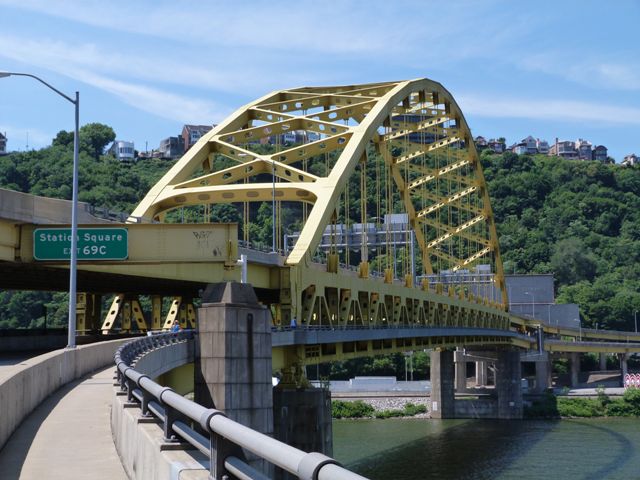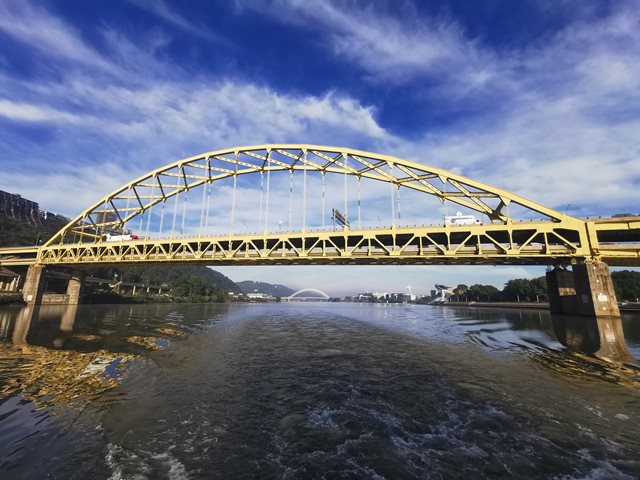We Recommend:
Bach Steel - Experts at historic truss bridge restoration.
BridgeHunter.com Phase 1 is released to the public! - Visit Now
Fort Pitt Bridge

Primary Photographer(s): Nathan Holth
Bridge Documented: June, 2004 - October 2, 2021
Pittsburgh: Allegheny County, Pennsylvania: United States
Metal Tied Solid Ribbed Through Arch, Fixed and Approach Spans: Metal Deck Girder, Fixed
1959 By Builder/Contractor: American Bridge Company of New York, New York and Engineer/Design: Richardson, Gordon, and Associates of Pittsburgh, Pennsylvania (George S. Richardson)
2003
750.0 Feet (228.6 Meters)
1,207.0 Feet (367.9 Meters)
51.8 Feet (15.79 Meters)
1 Main Span(s) and 4 Approach Span(s)
20279006100000

View Information About HSR Ratings
Bridge Documentation
View Archived National Bridge Inventory Report - Has Additional Details and Evaluation
View Historic American Engineering Record (HAER) Documentation For This Bridge
HAER Drawings, PDF (Previous Bridge) - HAER Data Pages, PDF (Previous Bridge)
View A Historical Article About The Previous Bridge At This Location
View Historical Engineering News-Record Article About Pittsburgh Which Includes This Bridge
This bridge is the larger of two nearly identical bridges (the other is the Duquesne Bridge over Allegheny River) that cross the two rivers just before they merge to form the Ohio River. Built during the time of urban renewal, two of the finest bridges in Pittsburgh were demolished to make way for these structures. The Fort Pitt Bridge was the replacement for the Point Bridge (See HAER documentation link above).
The Fort Pitt Bridge's main arch span is about 200 feet longer than the Duquesne Bridge's main span. The arch design of the bridge is uncommon... steel through arch bridges have historically been an uncommon structure type, although Pittsburgh has a relatively large number. As such, the bridge is not locally distinguished in terms of historic significance, with structures such as the West End Bridge or 16th Street nearby. However, the bridge would be a noteworthy feature if located elsewhere in the country, so it has a decent National HSR rating given its relatively late 1959 construction.
The bridge features traditional period construction, which includes the continued use of rivets and built up members. Traditional period construction is further expressed with the continued use of built-up members, but using the period techniques that use either plate steel or plate steel with holes in place of v-lacing and lattice. Other structural design features of the bridge include an arch that is not trussed, and cable verticals. The bridge features a double-deck design. The decks are essentially supported to what amounts to a Warren truss structure. It is interesting to note that despite the size of the bridge, the fabricator and/or contractor of the bridge remains unknown. George S. Richardson was the engineer of the structure.
Despite being relatively young, the Fort Pitt Bridge is far more attractive than any modern bridge could hope to be, and along with the Duquesne Bridge and the West End Bridge, they form a somewhat pleasing symmetry to the downtown landscape, which is greatly defined by these three great rivers and the bridges that span in this area.

Above: Photo showing the suspension bridge that was at this location from 1877-1927. Source: Library of Congress
This bridge is tagged with the following special condition(s): Unorganized Photos
![]()
Photo Galleries and Videos: Fort Pitt Bridge
Bridge Photo-Documentation
Original / Full Size PhotosA collection of overview and detail photos. This gallery offers photos in the highest available resolution and file size in a touch-friendly popup viewer.
Alternatively, Browse Without Using Viewer
![]()
Bridge Photo-Documentation
Mobile Optimized PhotosA collection of overview and detail photos. This gallery features data-friendly, fast-loading photos in a touch-friendly popup viewer.
Alternatively, Browse Without Using Viewer
![]()
Eastbound Crossing
Full Motion VideoThis video includes the approaching drive through the tunnel. This is the famous gateway entrance into downtown Pittsburgh. Streaming video of the bridge. Also includes a higher quality downloadable video for greater clarity or offline viewing.
![]()
Westbound Crossing
Full Motion VideoThis video includes the drive through the tunnel. Streaming video of the bridge. Also includes a higher quality downloadable video for greater clarity or offline viewing.
![]()
Westbound Crossing
Full Motion VideoStreaming video of the bridge. Also includes a higher quality downloadable video for greater clarity or offline viewing.
![]()
Additional Unorganized Photos
Original / Full Size PhotosA supplemental collection of photos that are from additional visit(s) to the bridge and have not been organized or captioned. This gallery offers photos in the highest available resolution and file size in a touch-friendly popup viewer.
Alternatively, Browse Without Using Viewer
![]()
Additional Unorganized Photos
Mobile Optimized PhotosA supplemental collection of photos that are from additional visit(s) to the bridge and have not been organized or captioned. This gallery features data-friendly, fast-loading photos in a touch-friendly popup viewer.
Alternatively, Browse Without Using Viewer
![]()
Maps and Links: Fort Pitt Bridge
Coordinates (Latitude, Longitude):
Search For Additional Bridge Listings:
Bridgehunter.com: View listed bridges within 0.5 miles (0.8 kilometers) of this bridge.
Bridgehunter.com: View listed bridges within 10 miles (16 kilometers) of this bridge.
Additional Maps:
Google Streetview (If Available)
GeoHack (Additional Links and Coordinates)
Apple Maps (Via DuckDuckGo Search)
Apple Maps (Apple devices only)
Android: Open Location In Your Map or GPS App
Flickr Gallery (Find Nearby Photos)
Wikimedia Commons (Find Nearby Photos)
Directions Via Sygic For Android
Directions Via Sygic For iOS and Android Dolphin Browser
USGS National Map (United States Only)
Historical USGS Topo Maps (United States Only)
Historic Aerials (United States Only)
CalTopo Maps (United States Only)





